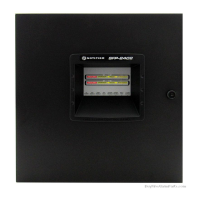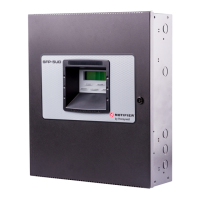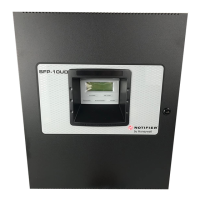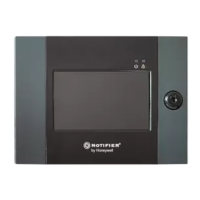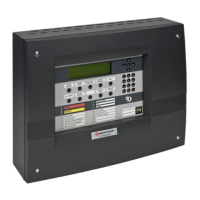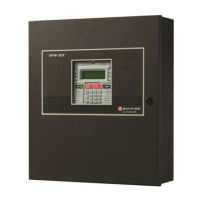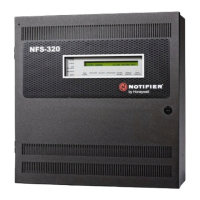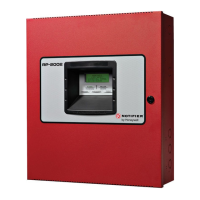Notifier SLC Wiring Manual — P/N 51253:U9 12/3/2021 13
Polling Protocols Introduction
1.5 Polling Protocols
1.5.1 Available Protocols
FlashScan
FlashScan® is a patented system (US Patent Number 5,539,389) that greatly enhances the speed of communication between analog
intelligent devices. Communication is in a grouped fashion. If one of the devices within the group has new information, the panel CPU
stops the group poll and concentrates on single points. Not all panels are FlashScan® capable; see “Protocol Use” below.
CLIP
CLIP (Classic Loop Interface Protocol) polls devices in sequential order. Many but not all Flash-Scan-capable devices can be set to run
in CLIP mode; see installation sheet shipped with the device.
1.5.2 Protocol Use
Control panels can use more than one type of protocol, with some restrictions as discussed below.
SLM-318 loops on N16, LCM-320/LEM-320 loops on NFS2-640, NFS2-3030, NFS-3030 and NFS-640, and SLC loops on NFS-320
can run in FlashScan mode or CLIP mode. AFP-100, AFP1010, AFP-200, AFP-300/AFP-400, AM2020, and System 5000 with AIM-
200 run in CLIP mode only.
Many FlashScan devices can be programmed to run in either CLIP or FlashScan mode. Use one of the following three options with SLC
loops on most panels:
1. Program all modules and detectors on an SLC as FlashScan.
2. Program all modules and detectors on an SLC as CLIP.
3. Program all detectors as CLIP and all modules as FlashScan on an SLC. (See Item#4 below.)
N16 and NFS2-3030/NFS-3030 support an additional option:
4. Program modules as CLIP and detectors as FlashScan.
1.6 Devices
1.6.1 Monitor/Zone Interface Module
These addressable modules allow the control panel to monitor entire circuits of conventional alarm initiating devices, such as manual
pull stations, smoke detectors, heat detectors, waterflow, and supervisory devices.
• FMM-1 Monitor Module; FlashScan or CLIP mode. (An earlier module named MMX-1 was CLIP mode only.)
• FMM-101 Addressable Mini-Monitor Module; FlashScan or CLIP mode. (An earlier module named MMX-101 was CLIP mode
only.)
• FMM-4-20 Four-to-Twenty Milli-Amp Monitor Module; FlashScan mode only. CLIP mode operation will generate a trouble
message at the panel. This module is only compatible with the NFS2-3030.
• FZM-1 Zone Interface Module; FlashScan or CLIP mode. (An earlier module named MMX-2 was CLIP mode only).
• SLC-IM SLC Integration Module communicates between the VHS-1420-HFS and a Fire Alarm Control Panel (FACP). It translates
Modbus protocol to SLC protocol enabling events on the VESDAnet to be annunciated by an FACP.
• XP5-M Supervises five Class B addressable Initiating Device Circuits (IDC) which monitor normally open contact initiating
devices. Supports FlashScan or CLIP mode. This module is capable of participating in degraded mode where supported by the
FACP. (See the XP5 Series Manual.)
• XP6-MA Allows an intelligent alarm system to monitor six zones of conventional two-wire detectors; FlashScan or CLIP mode.
• XP10-M Supervises ten Class B addressable Initiating Device Circuits (IDC) which monitor normally open contact initiating
devices; FlashScan or CLIP mode. This module is capable of participating in degraded mode where supported by the FACP.
1.6.2 Control Modules
Through these addressable modules, the control panel can selectively activate Notification Appliance Circuits (NAC).
• FCM-1 Control Module; FlashScan or CLIP mode. (Earlier monitor modules named CMX-1 and CMX-2 were CLIP mode only.)
CAUTION:
DO NOT PROGRAM MORE THAN 99 ADDRESSES ON A CLIP-MODE SLC LOOP, BECAUSE THIS WILL SLOW THE
SYSTEM DOWN AND COMPROMISE THE RESPONSE TIME OF THE PANEL TO DISPLAY OFF-NORMAL EVENTS.
CAUTION:
DO NOT PROGRAM MODULES AS CLIP AND DETECTORS AS FLASHSCAN ON THE SAME SLC UNLESS
SUPPORTED BY PANEL PROGRAMMING (SEE ITEM#4 BELOW). THIS COMBINATION DOES NOT WORK.
NOTE: In this manual, UL-listed model numbers are used; the ULC-listed versions are specified in Section E, “Canadian Versions of SLC
Devices”, on page 78. Only N16 supports self-test devices. Current release of N16 is for UL applications. If Self Test Smoke Detectors are
installed on a SLM-318 loop card (CLP-2PCB), the maximum permissible long line resistance drops to 35 ohms; initial release of SLM-318
drops to 23 ohms (CLP-PCB).
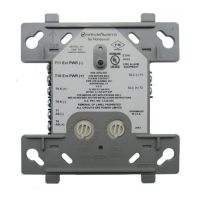
